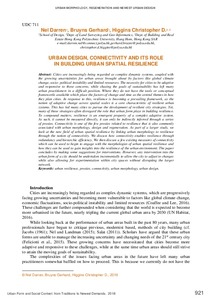Показать сокращенную информацию
URBAN DESIGN, CONNECTIVITY AND ITS ROLE IN BUILDING URBAN SPATIAL RESILIENCE
| Автор | Nel, Darren | |
| Автор | Bruyns, Gerhard | |
| Автор | Higgins, Christopher D. | |
| Дата внесения | 2019-07-10T10:02:07Z | |
| Дата, когда ресурс стал доступен | 2019-07-10T10:02:07Z | |
| Дата публикации | 2019-05 | |
| ISBN | 978-5-7638-4127-5 | |
| URI (для ссылок/цитирований) | https://elib.sfu-kras.ru/handle/2311/111769 | |
| Описание | Proceedings of the XXV ISUF International Conference “Urban Form and Social Context: from Traditions to Newest Demands” (Krasnoyarsk, July 5–9, 2018) | ru_RU |
| Аннотация | Cities are increasingly being regarded as complex dynamic systems, coupled with the growing uncertainties for urban areas brought about by factors like global climate change, socio- political instability and limited resources. The necessity for cities to be adaptive and responsive to these concerns, while chasing the goals of sustainability has left many urban practitioners in a difficult position. Where they do not have the tools or conceptual frameworks available which place the factors of change and time as the central themes in how they plan cities. In response to this, resilience is becoming a prevailing framework, as the notion of adaptive change across spatial scales is a core characteristic of resilient urban systems. This has led many cities to pursue the development of resilient city strategies. Yet, many of these strategies often disregard the role that urban form plays in building resilience. To compound matters, resilience is an emergent property of a complex adaptive system. As such, it cannot be measured directly, it can only be indirectly inferred through a series of proxies. Connectivity is one of the few proxies related to resilience that is also commonly associated with urban morphology, design and regeneration. As part of a larger study, we look at the new field of urban spatial resilience by linking urban morphology to resilience through the notion of connectivity. We discuss how connectivity enables resilience through redundancy and hierarchic efficiency. We then discuss a few existing measures of connectivity which can be used to begin to engage with the morphologies of urban spatial resilience and how they can be used to gain insights into the resilience of the urban environment. The paper concludes by making some suggestions for interventions. However, any intervention into the urban form of a city should be undertaken incrementally to allow the city to adjust to changes while also allowing for experimentation within city spaces without disrupting the larger network. | ru_RU |
| Язык | en | ru_RU |
| Издатель | Siberian Federal University | ru_RU |
| Издатель | Сибирский федеральный университет | ru_RU |
| Тема | urban resilience, proxies, connectivity, urban morphology, urban design. | ru_RU |
| Название | URBAN DESIGN, CONNECTIVITY AND ITS ROLE IN BUILDING URBAN SPATIAL RESILIENCE | ru_RU |
| Тип | Conference Item | ru_RU |
| Тип | Conference Paper | ru_RU |
| Контакты автора | Nel, D., Bruyns, G., Higgins, C. D. : 1School of Design, 2Dept. of Land Surveying and Geo-Informatics, 3Dept. of Building and Real Estate Hong Kong Polytechnic University, Hung Hom, Hong Kong SAR e-mail:darren.nel@connect.polyu.hk,gerhard.bruyns@polyu.edu.hk, christopher.d.higgins@polyu.edu.hk | ru_RU |
| Страницы | 921- 930 | ru_RU |
| Место издания | Красноярск | ru |
| Место издания | Krasnoyarsk | en |

